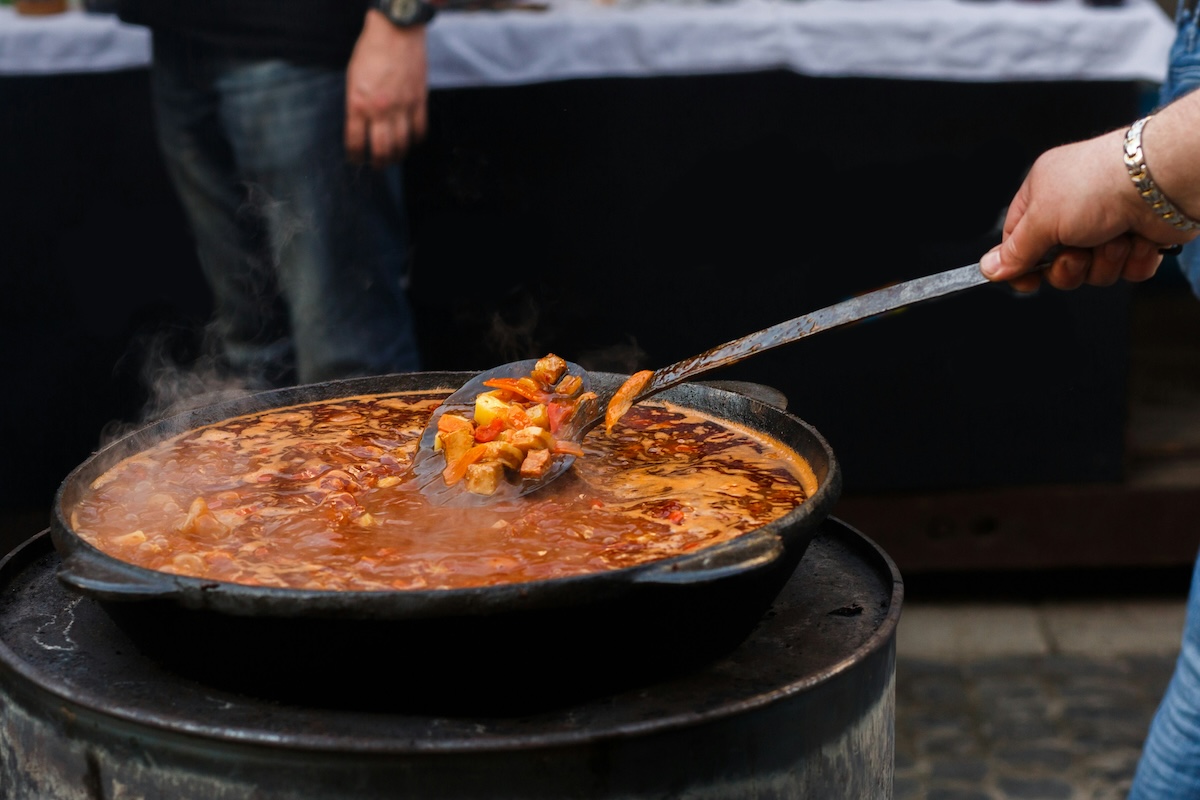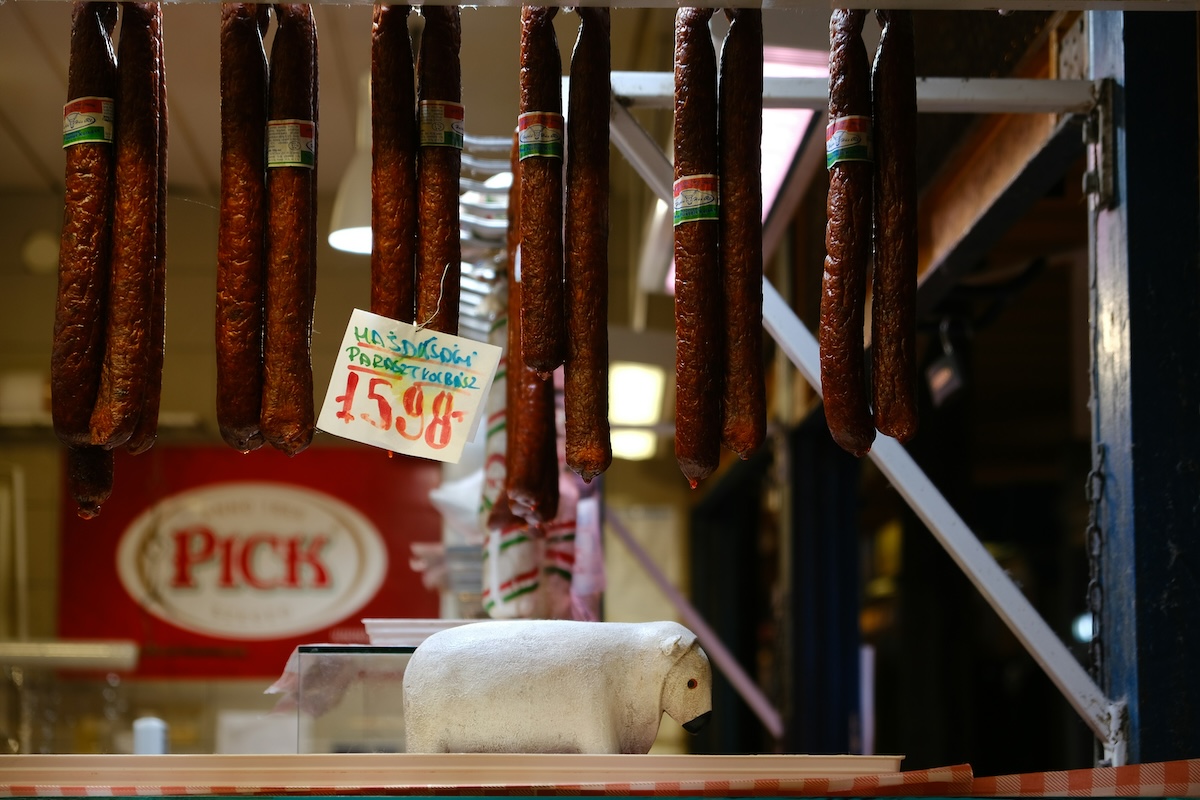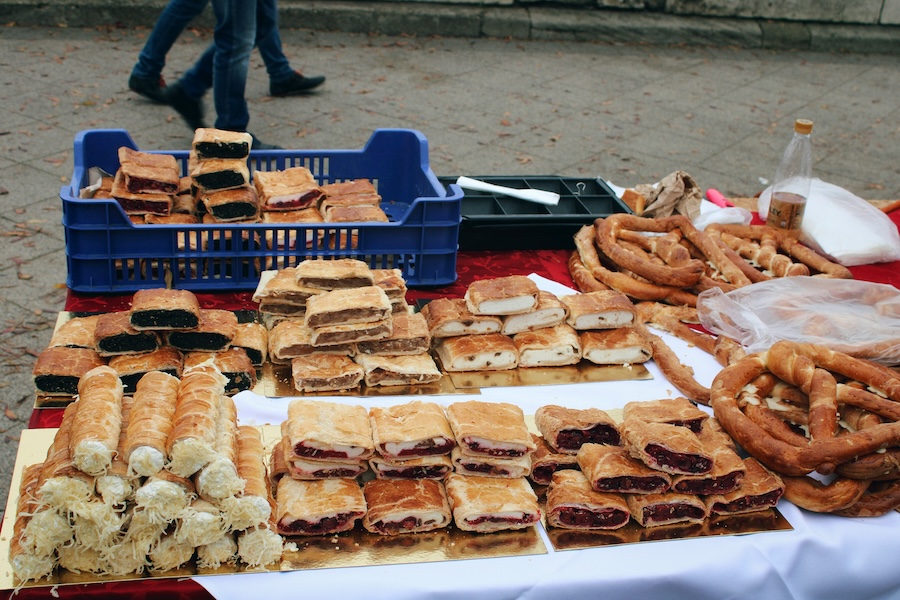Hungarian cuisine is rich in flavours, spicy, and greasy. It’s characterised by lots of meat, bread, seasonal vegetables, and dairy products, thanks to the various ethnic groups that were and are present in Hungary. Hungarian cuisine was influenced by its neighbouring countries and other foreign cultures.
The most important spice in Hungarian cuisine is paprika, a bright red-coloured powder with distinct heat, that ranges from milder to more spicy variations. Other notable spices in Hungarian cuisine are garlic, caraway seeds, marjoram, and dill seeds.
Hungarian cuisine employs lots of meat, usually pork meat. Chicken, turkey, beef, and various fishes are also common ingredients in Hungarian dishes.
Bread is also an important part of Hungarian cuisine. Many courses are the most enjoyable when one eats bread together with the course.
The main courses consist of 2 parts in Hungarian cuisine: 1) meat (e.g. fried chicken), and 2) a side dish (in Hungarian: köret) like rice, French fries etc.
The most typical Hungarian dishes are the following.
- Goulash (cattleman’s meal)
- Halászlé (fish soup or fisherman’s soup)
- Cold fruit soups
- Stew made of various types of meat
- Chicken paprikash (csirkepaprikás)
- Pottage (főzelék): vegetable stew made of various vegetables.
- Hortobágyi húsos palacsinta (savory pancake filled & stuffed with meat stew)
- Szilvásgombóc (dumpling stuffed with cooked plum)
- Túrógombóc (dumpling stuffed with sweet cottage cheese)
- Palacsinta (pancake)
Other notable dishes are sausages. These are served either baked or cold. Hungarian cuisine has a meal called cold dish (hidegtál) that consists of several sausages, smoked ham, salami, bread, and seasonal vegetables. This dish is usually served as breakfast or dinner, but also often served as a starter in restaurants.
Hungarian cuisine employs many seasonal vegetables like cabbage, pepper, tomato, turnip, and carrot. And also fruits, like apple, peach, plum, pear etc.
Hungary is famous for its wines as the country has 22 different wine regions. A famous drink in Hungary is fröccs: wine combined with mineral water in different combinations.
Other notable drinks in Hungary are pálinka (alcoholic fruit spirit), Unicum (bitter liquor made of many herbs), beers, mineral water, and szörp (thick fruit concentrate mixed with water).
For international & Erasmus students in Budapest, getting to know Hungarian gastronomy is an experience in itself. The easiest step is to start with our national dish.
What is the national dish of Hungary?
The national dish of Hungary is goulash. In Hungarian it’s called gulyás which means ‘cattleman’s meal’. Goulash is a thick beef soup made with paprika, potato, carrot, turnip, celery, onion, parsley, and many more ingredients.
There is a debate whether goulash is a soup or stew. In reality goulash is somewhere between the middle: it’s not too thick that it would make it a stew, but thicker than a typical soup. In Hungary we consider it a soup, and if you look for it on the menu you’ll most likely find it in the soups’ section.
Despite the fact that Hungary has many famous dishes, goulash is the top favourite and most well-known dish among foreigners. The funny thing is, Hungarian people rarely eat goulash in their everyday lives. They eat goulash sometimes during lunch.
Goulash is typically made in a big cauldron (in Hungarian bogrács), this is why it’s mostly consumed during garden parties.
What is a typical Hungarian breakfast like in Hungarian cuisine?
A typical breakfast in Hungary consists of mainly cold dish items. People in Hungary usually eat sausage, smoked ham, salami, cheese, butter, vegetables, bread, baked egg, and sometimes scrambled egg for breakfast.
Another beloved meal in the breakfast is various jams with buttered bread. The most widely loved and used jams in Hungary are made of peach and plum.
In Hungary there’s usually another mealtime between breakfast and lunch called ‘tízórai’, which means ‘meal at 10 am’. During uzsonna Hungarian people typically eat a sandwich with cheese and/or salami, or ham.
What is a typical Hungarian lunch like in Hungarian cuisine?
A typical Hungarian lunch consists of either 2 or 3 courses: soup, a main course, and (optionally) a dessert.
Soup is usually something light on the weekdays, like meat soup, vegetable soup, bean soup etc., or – during warmer seasons – cold fruit soup.
Hungarian people typically eat some type of meat for a main course with a side, like rice or French fries.
Palacsinta is the most beloved type of dessert in Hungary filled with peach jam, or sweet cottage cheese, or Nutella.
Other beloved desserts in Hungary are somlói galuska (Somló-style sponge cake with chocolate syrup, vanilia, and nuts), mákos guba (slices of sweet kifli – a type of bread – with poppy seeds soaked in vanilla sauce) and gesztenyepüré (cooked and mashed sweet chestnuts mixed with sugar and rum, topped with whipped cream).
A typical everyday lunch example in Hungary looks like this.
- Meat soup
- Fried pork with rice
- Palacsinta for dessert
In Hungary, there is another meal time between lunch and dinner we call ‘uzsonna’. There aren’t any definitive translations of this word. It means something similar to a snack. A snack that we eat before dinner.
Uzsonna is typically a light sandwich with salami, cheese, and vegetables. Or a sweet snack like túró rudi (sweet cottage cheese bar coated in chocolate). Túró rudi is the most popular sweet afternoon snack in Hungary.
What is a typical Hungarian dinner like in Hungarian cuisine?
A typical Hungarian dinner includes bread, butter, sausage, salami, ham, cheese and vegetables. These are the centrepieces of a typical Hungarian dinner.
Dinner in Hungary is quite similar to breakfast with some differences like the quantity. Hungarians tend not to eat too much greasy stuff (like too much meat). It wouldn’t feel good going to bed with all the heavy food in our stomach. 🙂
What is the typical seasoning of Hungarian cuisine like?
Hungarian seasoning is quite spicy with vibrant and rich flavours, but usually not hot. Paprika is the centrepiece of almost all notable Hungarian meals and thus one of the most dominating flavours in Hungarian meals.
The use of hotter spices like chilli paprika is usually optional in Hungarian cuisine, and is always provided separately (e.g. in a separate bowl) for the guests.
Spiciness in Hungarian cuisines is often balanced by the excessive use of sour cream. While sour cream is usually served separately to a meal as an optional topping, many Hungarian dishes have sour cream amongst their ingredients.
Other notable herbs and spices Hungarian cuisine employs are salt, pepper, garlic, caraway seeds, marjoram, and dill seeds.
The herbs and spices that Hungarian cuisine uses today were highly influenced by the many ethnic groups and conqueror countries throughout Hungarian history.
Brief history of Hungarian cuisine
The foundation of Hungarian gastronomy lies in the pastoral traditions of the Magyar tribes, who valued meats such as pork, beef, and mutton, which remain central to the country’s culinary practices today. Hungarian culture’s nomadic origins are carried further in iconic dishes like goulash and pörkölt, which were traditionally prepared in a cauldron over an open fire.
The introduction of new spices and cooking methods can be traced back to the mediaeval era, particularly under the reign of King Matthias Corvinus in the 15th century, who brought influences from the Italian Renaissance, including the introduction of garlic and onions.
This period also saw the introduction of fruits in savoury dishes, enhancing the complexity of flavours in Hungarian cuisine.
The 16th and 17th centuries brought further diversification with the Ottoman occupation, introducing paprika, along with a variety of vegetables like peppers and tomatoes. These ingredients were vital in developing the rich, hearty stews and vibrant flavours that characterise Hungarian dishes today.
During the Austro-Hungarian Empire, the cuisine was influenced by Austrian cooking methods. This cross-cultural “entanglement” enriched Hungarian cuisine, introducing techniques and desserts that demonstrate a strong German-Austrian influence.
The Austro-Hungarian Empire was also responsible for the proliferation of coffeehouse culture in Hungary back in the 19th century.
The 20th century saw further evolution with the introduction of modern agricultural techniques, increasing the availability of ingredients, which allowed traditional recipes to be cooked with greater consistency and experimentation.
Today, Hungarian cuisine remains a testament to its rich history, characterised by its innovative use of spices like paprika, and ingredients like onions, garlic, and meats. The spirit of traditional dishes and ingredients is carried further in today’s street food culture of Hungary. Soups and pottages especially have a huge renaissance now in Hungary.
What is typical Hungarian food?
Typical Hungarian foods include many traditional dishes, for example the following.
- Goulash
- Halászlé (fish soup or fisherman’s soup)
- Cold fruit soups
- Stew made of various types of meat: The most popular stew in Hungary is from beef, but chicken and pork stew is also very famous.
- Chicken paprikash (csirkepaprikás)
- Pottage (főzelék): vegetable stew made of various vegetables like pea, bean, potato, corn etc.
- Hortobágyi húsos palacsinta (savory pancake filled & stuffed with meat stew)
- Szilvásgombóc (sweet dumpling stuffed with cooked plum)
- Túrógombóc (sweet dumpling stuffed with sweet cottage cheese)
- Palacsinta (pancake)
Hungarian cuisine can be grouped into four categories:
- Soups
- Main courses
- Cold cuts
- Desserts
- Snacks
- Street food
- Drinks
Typical Hungarian soups
The most typical Hungarian soups are the following.
- Goulash: thick beef soup made with paprika, potato, turnip, and many more ingredients.
- Fish soup: thick soup made with paprika and river fish.
- Meat soup: slow cooked broth made with beef, bones, carrot, potato, served with noodles.
- Bean soup: thick Hungarian soup made with beans, paprika, potato, and beef.
- Vegetable soup: light Hungarian soup usually made with peas, potato, carrot, turnip, served with noodles.
- Pea soup: light Hungarian soup made with peas, carrot, turnip, often served with galuska (little boiled dumplings).
- Potato soup: light Hungarian soup made with potato, sour cream, paprika, marjoram, and bay leaf.
- Palócleves: soup palóc style, a pork soup with potato and sour cream.
- Mushroom soup: thick Hungarian soup made with mushroom, carrot, potato, and paprika.
- Cold fruit soup: light sweet soup mostly made of cherry and apple.
Typical Hungarian main courses
The most typical Hungarian soups are the following.
- Beef stew (marhapörkölt)
- Pork stew (sertéspörkölt)
- Chicken paprikash (csirkepaprikás): chicken stew made with paprika, sour cream, served with little dumplings called ‘nokedli’.
- Paprikás krumpli: potato stew, a thick stew made of boiled potato, paprika, and spicy sausage.
- Pottage: vegetable stew made from various vegetables like pea, bean, potato, corn.
- Hungarian ratatouille (lecsó): similar to the traditional ratatouille but cooked without zucchini and eggplant. Sometimes cooked with ham and/or egg.
- Stuffed cabbage: töltött káposzta, boiled cabbage stuffed with rice and pork meat.
- Hortobágyi húsos palacsinta: savoury pancake stuffed with meat stew and topped with the stew’s sauce and sour cream.
- Fried pork or chicken with rice and/or French fries.
- Cigánypecsenye: gypsy roast, consists of pork, ham, fresh vegetables, and fries.
- Brassói aprópecsenye: diced pieces of pork mixed with French fries.
Typical Hungarian sausages & cold cuts
The most typical Hungarian sausages & cold cuts are the following.
- Hurka: boiled sausage, it’s like black pudding.
- Various cold spicy sausages from 3 main cities of Hungary: Gyula, Békéscsaba, and Debrecen.
- Téliszalámi: winter salami, a famous Hungarian cold cut that can be purchased in every supermarket in Hungary. The most genuine and quality is from Pick.
- Szalonna: Hungarian bacon, made from the back of pork, has more fat than usual bacon.
- Virsli: basically a Frankfurter-type thin sausage, usually consumed either cold or hot, with bread, and with sauces like mustard or ketchup.
Typical Hungarian desserts
The most typical Hungarian desserts are the following.
- Palacsinta: Hungarian pancake, stuffed with various jams (usually peach), sweet cottage cheese, or Nutella, then rolled.
- Somlói galuska: Somló-style sponge cake with chocolate syrup, vanilia, and nuts.
- Mákos guba: slices of sweet kifli – a type of bread – with poppy seeds soaked in vanilla sauce.
- Gesztenyepüré: cooked and mashed sweet chestnuts mixed with sugar and rum, topped with whipped cream.
- Szilvásgombóc: sweet dumpling stuffed with cooked plum.
- Túrógombóc: sweet dumpling stuffed with sweet cottage cheese.
- Kürtőskalács: chimney cake, a traditional cylindrical-shaped pastry, baked over coals. Sold in either vanilla or cinnamon flavour.
- Dobostorta: Dobos cake, a layered sponge cake with chocolate filling, topped with a thin layer of crunchy caramel.
- Bejgli: sweet cake roll stuffed with either nut cream or poppy-seed cream. Hungarians only eat this during Christmas.
What is the most popular snack in Hungary?
The most popular and best snack in Hungary is túró rudi. Túró rudi is a sweet cottage cheese cylinder-shaped bar, coated in chocolate. Sometimes it’s also stuffed with some sort of jam, but the traditional túró rudi is just sweet cottage cheese and chocolate.
Túró rudi is available in all supermarkets and local grocery stores in Hungary.
Another notable snack in Hungary is Pilóta keksz or ‘pilot cookie’, a layered cookie with a chocolate and vanilla cookie with chocolate cream between them).
Typical Hungarian drinks
The most typical Hungarian desserts are the following.
- Wines: Hungary has 22 different wine regions all over the country. The most famous wines are Tokaji Aszú, white wines, and red wines.
- Pálinka: alcoholic fruit spirit made of different fruits.
- Unicum: a bitter liquor made of many herbs
- Beers
- Mineral water
- Szörp: Szörp is a thick fruit concentrate available in different flavours like cherry and strawberry, mixed with water.
Typical Hungarian street food
There is a boom in the street food culture in Budapest that brought back or improved many traditional Hungarian dishes. The most typical Hungarian street foods in Budapest are the following.
- Soup
- Pottage
- Grilled sandwich
- Hamburger
- Lángos: Lángos is a traditional Hungarian fried flatbread, made of soft dough, and is consumed mostly during summer in Hungary.
- Kürtős kalács
- Kenyérlángos: Kenyérlángos is basically the Hungarian version of Italian pizza. It’s made of bread dough and is topped with traditional Hungarian toppings like bacon, red onion, and sour cream. We also call it ‘langalló’ or ‘töki pompos’.
Typical dishes you should try during your Erasmus in Hungary
We listed many amazing Hungarian dishes, but you might even can’t try all of them during your Erasmus in Budapest. Unless you are a gastro lover.
To make your decision easier, here is a shortened list of all the Hungarian dishes you must try during your Erasmus.
- Goulash
- Pottage
- Chicken paprikash
- Meat stew
- Lángos
- Kürtős kalács
- Palacsinta
- Túró rudi
You can try to cook some of them at home! Grocery stores in Budapest have all the necessary ingredients for these amazing dishes. Or you can go to a Hungarian restaurant.
Where can I eat authentic Hungarian food in Budapest?
You can eat authentic Hungarian food in Hungarian restaurants in Budapest. Here are some of the best Hungarian restaurants in Budapest.
- Pozsonyi Restaurant: at Jászai Mari tér, next to the Danube.
- Paprika Vendéglő: next to Városliget, a 13-minute walk from Heroes’ Square.
- Frici Papa: located in Király utca, in the vicinity of Oktogon, just a 2-minute walk from the tram 4-6 stop nearby.
- Vakvarjú: it has more locations, but the most central is at the Bajcsi-Zsilinszky út metro line 1 station.
- Gettó Gulyás: located in the heart of Jewish Quarter in Wesselényi utca.







